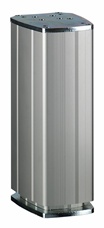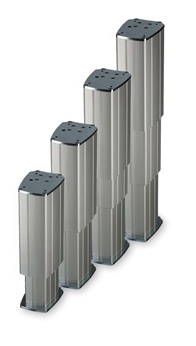Kyle Thompson
Global Product Line Manager, Systems
Thomson Industries, Inc.
Vertical lift is required in a wide range of medical equipment where accessibility and comfort improve care and patient outcomes. Applications such as wheelchair lifts, examination tables, dental chairs, adjustable nurses’ stations and optician instruments all require vertical lift to provide appropriate care and an optimal patient experience. Designers of medical equipment need lifting columns that are cost effective and provide a high-user experience.
Maximizing speed and extension-to-retraction ratio
A lifting column must offer a combination of speed and performance. A competitive edge can be gained if equipment can handle a high-load capacity and provide stroke length, which meets the Americans with Disability Act’s legal height requirements while operating at a speed to maintain efficiency of operation. Innovative designs of lifting columns that are currently available make this possible by using a telescopic lead screw with a nesting three-piece extrusion to enable a surprisingly small minimum retracted length and great extension-to-retraction ratio. These devices are ideal for use in machines such as wheelchairs or examination tables as well as ergonomic workstations. This technology can handle up to 2000 N loading with operation speeds of up to 25 mm/s.
High load capacity
For bariatric and chiropractic applications, high-load capacity is of utmost importance. A load capacity of up to 3000 N with high moment loading in a compact frame size is achieved by using a ball screw with a three-piece extrusion, which has additional extrusion overlap to allow for extended-length bushings. The resulting lifting column can have a short retracted length and deliver the smooth, quiet operation required for medical or home environments.
Noise reduction
Low, consistent, and smooth noise operation provides an ideal medical environment. High-performance linear actuators can be supplied with noise-deafening covers making them suitable for use in medical applications without the need to add additional noise attenuation. The use of a single motor and screw further ensures smooth operation and patient comfort, while also allowing for lower amp draw and longer life.
Enhanced ergonomics
Telescopic lifting columns maximize the extension to retraction ratio and give the flexibility in range of movement required to improve patient, doctor and operator ergonomics. For example, powered wheelchairs will feature a minimal retracted height making it easier for patients to get into the chair and also offers high extension which lets users reach high objects, such as wall cabinets. Equipment such as examination tables or dentistry chairs can be adjusted to let patients get on easily and then quickly and smoothly be moved to the optimum height to ensure physician comfort and reduce the risk of back injuries. Additionally, using a column that provides rapid movement further ensures comfort and safety without compromising equipment integrity.
Bearing the load
Other innovative design features in modern lifting columns include the ability to handle increased moment loads. The use of stand-alone actuators provide lifting force while handling potential moment loads of up to 400 Nm. To provide column moment loading capability, an engineered polymer slide bushing is used that slides along the extrusion as the column telescopes and is keyed to enable about 40% more moment load than alternate designs.
In applications where there is too much side load for a single column, designers may synchronize two to four lifting columns together. The resulting system will offer more stability, load capacity and moment load capacity, as required. For all configurations of installation, a loading brake is vital to ensure the load is held even on power failure to provide complete safety for the user.
Reducing overall machine and lifetime costs
Making the outside of lifting columns aesthetically pleasing eliminates the need for additional covers or shrouds. This simplifies machine design and reduces manufacturing costs.
Pre-drilled mounting holes allow for easy mounting and integration into the machine. The lifting column will automatically shut off at end-of-stroke as the limit switches are internally wired in series with the motor power. No limit switch wiring is required from the user.
Fully enclosed columns can use high viscosity grease to prolong life. The Thomson LC series lifting columns, for example, provide 10,000 cycles at full load, giving reliable lifetime performance with no ongoing maintenance or greasing requirements to help reduce lifetime costs.
Fulfilling application and budget requirements
To meet application and budget requirements, the right balance between extension-to-retraction ratio, load capacity, speed and cost is necessary. For medical applications, quiet, smooth operation is an obvious benefit. Ease of installation, ongoing maintenance and footprint of a lifting column solution are also factors machine designers must consider.
Light weight, quiet operation for cost-sensitive applications. For applications such as baby incubators, optician testing machines and mobile carts, the extension-to-retraction ratio is not as critical. Stroke lengths of up to around 400mm and loading capacity of up to approximately 1600 N are usually adequate. It is important to have competitively priced solutions with exceptionally quiet operation for these applications.
Meeting exact requirements. There are a vast range of lifting columns available–each with features and benefits that may make them more or less favorable for a given application. Most equipment can also be customized to meet exact requirements such as higher retracted lengths, mounting plates with customer specific mounting arrangements, special cable lengths and double or extended bushings.
Modern technological advancements mean that whatever the application, machine builders can get the features they need in a solution which is cost-effective and easy to install while providing a better overall equipment performance and user experience.

Thomson’s LC 2000 is an easy to install, low-cost ergonomic solution that is said to increase operator and patient comfort.

Modern innovations in lifting column technology mean medical machine builders can design without compromise, taking advantage of easy installation and superior performance while reducing overall costs.


